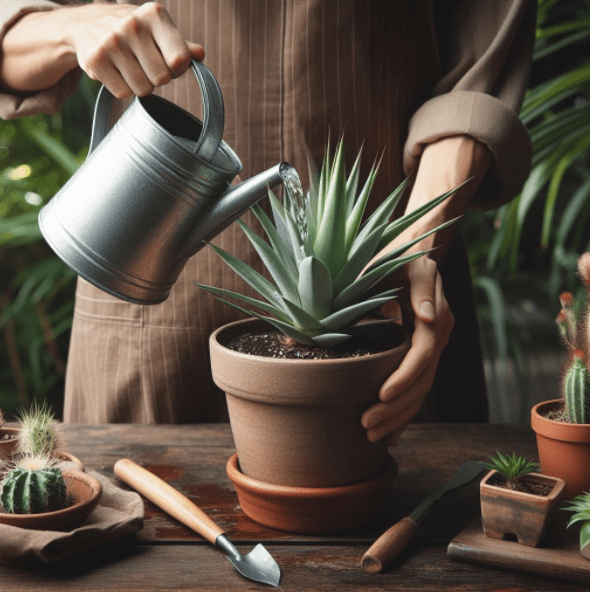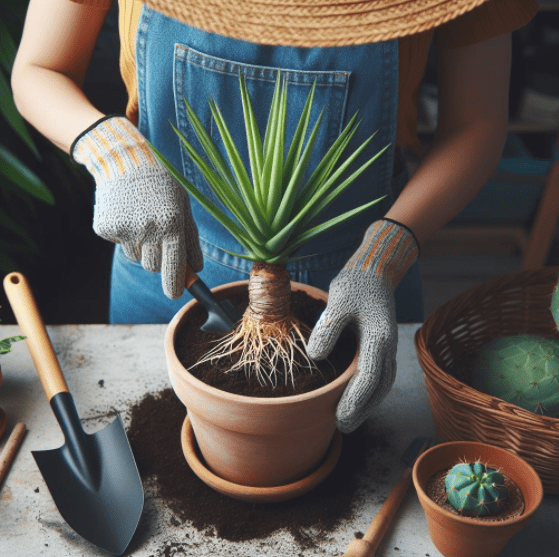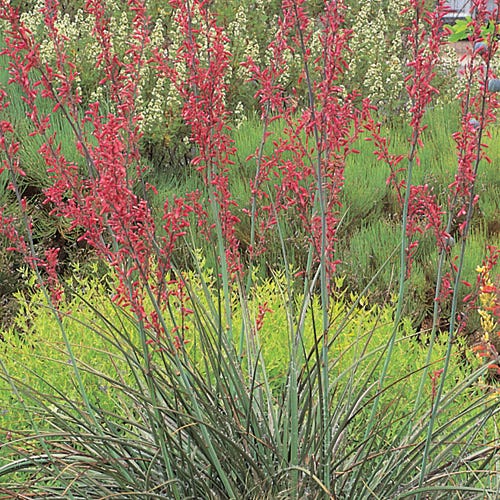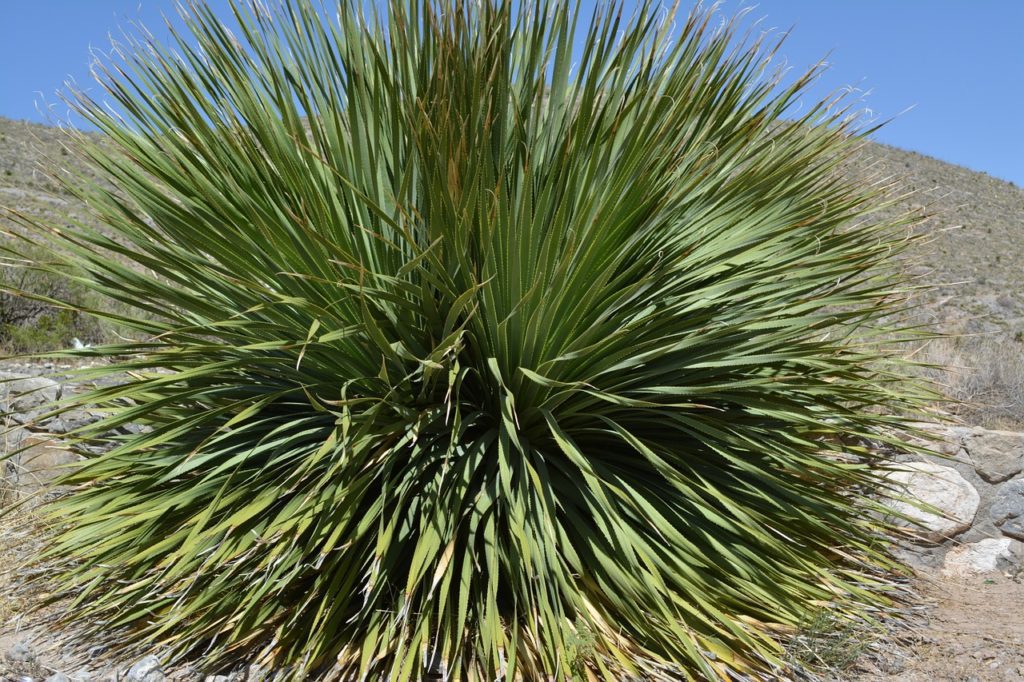The yucca plant is a genus of many perennial plants, trees, and shrubs; however, few are found as houseplants labeled “yucca plant.”
Important Note for Pet Owners: Yucca plants are toxic to animals and can cause vomiting, drooling, and other issues. Keep your Yucca out of reach of pets for their safety.
How Much Light Does an Indoor Yucca Plant Need?
Indoor Yucca plants thrive in bright, indirect light. Here’s a breakdown of what that means and how to ensure your yucca gets enough light:
What is Bright, Indirect Light?
- Bright: A location with plenty of natural light throughout the day, but without harsh, direct sun rays hitting the plant’s leaves.
- Indirect: The light is filtered through a sheer curtain, or the plant is several feet away from a window, not directly in the sun’s path.
Yucca Plant Indoor Care – Ideal Placement for Yuccas
- South or East-facing window: Receives plenty of light early in the day, but becomes indirect as the sun moves.
- West-facing window: Be careful, as the afternoon sun can get too intense. If using a west-facing window, position the yucca further back in the room.
- Supplemental lighting: If you don’t have good natural light sources, invest in a grow light for your yucca.
Signs Your Yucca Needs More Light
- Slow growth: Little to no new growth.
- Legginess: Yucca becomes tall and spindly, stretching toward the light.
- Pale leaves: Leaves lose their vibrant green color.
Signs Your Yucca is Getting Too Much Light
- Brown spots: Dry, brown patches appear on leaves.
- Crispy leaf tips: Leaf tips turn brown and dry.
Important Note: If moving your yucca to a brighter location, gradually prevent shocking the plant.
Watering Your Yucca Plant The Right Way

Here are some tips on how to water your indoor Yucca plant properly:
The “Soak and Dry” Method
Yucca plants are adapted to arid environments and are sensitive to overwatering. The best practice is the “soak and dry” method:
-
Check the Soil: Before watering, stick your finger 2-3 inches into the soil. If it feels scorched, it’s time to water. If there’s any moisture, wait a few more days.
-
Water Thoroughly: When you water, do it thoroughly. Slowly pour water over the soil until the excess water starts draining out the pot’s drainage holes. This ensures the entire root system is saturated.
-
Empty the Saucer: Always empty any water in the drainage saucer beneath the pot. Letting your yucca sit in water can cause root rot.
-
Let it Dry: Do not water again until you’ve repeated the soil check in step 1 and it’s scorched. Depending on conditions, this could take a week to several weeks.
Signs of Overwatering
- Yellowing or dropping leaves
- Mushy stem at the base
- Foul odor from the soil
Signs of Underwatering
- Dehydrated and shrunken leaves
- Leaves curling inwards
Tips
- Terracotta Pots: These are ideal for yuccas, as they help the soil dry out more quickly between waterings.
- Bottom Watering: You can occasionally bottom water your yucca by placing the pot in a water basin for 10-15 minutes, allowing the soil to soak up moisture from the bottom.
Remember: It’s better to err on the side of underwatering a yucca than overwatering it. They are tough plants and can recover from underwatering more easily.
Best Soil and Fertilizing Practices for Your Indoor Yucca
Soil Matters
- Drainage is Key: Yuccas need well-draining soil to avoid root rot. Look for a potting mix specifically designed for cacti and succulents, or create your own.
- DIY Mix Recipe: Combine equal parts regular potting soil, sand, and perlite. This promotes good drainage aeration and mimics the sandy conditions yuccas prefer.
Fertilizing Your Yucca
- Moderate Feeders: Yuccas don’t require heavy fertilization. Plan to fertilize lightly during the active growing season (spring and summer).
- Fertilizer Choice: Choose a balanced liquid fertilizer for houseplants (like a 10-10-10 NPK ratio), diluted to half-strength.
- Fertilizing Frequency: Fertilize about once a month during the growing season. Avoid fertilizing during fall and winter when growth slows down.
- Signs of Overfertilization: Crusty white buildup on the soil, browning leaf tips
 Buy on Amazon
Buy on Amazon
Additional Tips
- Repotting Time: When you notice roots growing out of the drainage holes, it’s time to repot. Use fresh potting mix during repotting.
- Don’t Fertilize Immediately after Repotting: Fresh soil has enough nutrients; wait a couple of months before resuming fertilization.
Options for Quality Soil
- Pre-made mixes: Look for cactus/succulent potting mixes from brands like Espoma or Miracle-Gro.
- Specialty options: Some brands like Elm Dirt offer pre-mixed formulas specifically tailored towards promoting blooming and overall plant health.
Indoor Yucca Plant Temperature and Humidity
Yucca plants are adaptable and quite forgiving when it comes to temperature and humidity. Here’s what you need to keep in mind for your indoor yucca:
Temperature
- Ideal Range: Yuccas thrive in average household temperatures between 65°F – 85°F (18°C – 29°C).
- Consistency is Key: Avoid sudden temperature fluctuations caused by drafts, air vents, or open windows in very cold weather.
- Winter Tolerance: They can tolerate slightly cooler temperatures in winter, but make sure it doesn’t fall below 50°F (10°C) for extended periods.
Humidity
- Low-maintenance: Yuccas do well with the average humidity levels found in most homes.
- No Misting Needed: Misting isn’t necessary, and could even be harmful if water sits on the leaves for too long.
- Exceptionally Dry Air: If your home has extremely dry air (common in heated homes during winter), you can slightly increase humidity around the plant with these optional methods:
- Pebble tray: Place the yucca’s pot on a tray filled with pebbles and a little water. The evaporating water creates a microclimate of slightly higher humidity.
- Grouping plants: Placing your yucca near other houseplants naturally raises humidity in their immediate area.
Signs of Temperature Trouble
- Cold damage: Limp or mushy leaves, discolored spots on the foliage.
- Heat Stress: Dry, crispy leaves, excessive leaf drop.
Important Note: If you move your yucca outdoors for the summer, acclimate it slowly to direct sunlight and adjust watering accordingly.
Repotting Your Yucca: When and How

Joshua tree (Yucca brevifolia, Zones 5/6 to 9) poster plant of the Mojave desert, very tall, trunked, short yellow-green foliage
Y. faxoniana (Zones 6 to 9) is large, stiff, macho-looking, trunked, needs drier climates.
Y. harrimaniae dollhouse yucca (Zones 4 to 9) smallest species, stemless, spiny with white filaments, best in dry regions
Y. pallida (Zones 5 to 9) broad, gray-blue foliage, small, stemless, tolerates shade, heavy soil, moisture
Y. rigide (Zones 7 to 10) sharp, pale blue foliage, trunked, insists on dry conditions
Twist-leaf Yucca (Y. rupicola, Zones 5 to 9) olive-green undulating leaves with a golden margin, small, stemless, tolerates some moisture and shade.
Mountain yucca (Y. schottii. Zones 5 to 9) spiny, stiff, blue leaves, trunked, somewhat shade-and moisture-tolerant
Y. treculeana (Zones 7 to 10) dark green, spiny, trunked, large, tolerant of some moisture and humidity
| Botanical Name | Yucca spp. |
| Common Name | Yucca plant |
| Plant Type | Herbaceous perennials, shrubs, trees |
| Mature Size | Varies by variety |
| Sun Exposure | Full sun or bright, indirect sun |
| Soil Type | Sandy |
| Soil pH | 5.5 to 7.5 |
| Bloom Time | Mid-summer to early fall (flowers are not significant) |
| Flower Color | Creamy white, pink |
| Hardiness Zones | 4 to 11 (USDA) |
| Native Area | Hot, arid parts of the Americas and the Caribbean |
| Toxicity | Poisonous to animals; may cause skin irritation to humans. |
Red Yucca Plant
An exciting variety is of this plant is known as Red Yucca Plant, also called Texas Red Yucca (Hesperaloe)
Hesperaloe parviflora (Texas Red Yucca Plant) is one of the best drought-tolerant flowering succulents.
It is a hummingbird’s delight that produces tall spikes of reddish-pink flowers blooming all summer.
Are Yucca Plants Poisonous
Yucca plants contain steroidal saponins. Once ingested by animals, it provokes some or all of these symptoms: vomiting, drooling, dilated pupils, incoordination, and weakness.
However, it is much more dangerous for big animals drawn to this plant. Smaller domestic animals, dogs, and cats usually exhibit mild symptoms.
Conclusion
yucca plants are remarkably low-maintenance and add striking architectural beauty to any space. Remember the essentials:
- Bright, indirect light
- Water only when the soil is arid
- Well-draining soil and a pot with drainage holes
- Occasional, light fertilizing during the growing season.
Following these straightforward tips, you’ll enjoy your indoor yucca plant for years. If you encounter any challenges, the troubleshooting advice above should help you get your plant back on track.
Yucca Inspiration
With so many varieties of houseplant yuccas, from compact tabletop plants to dramatic statement pieces, there’s an option perfect for your home. Have fun and experiment!
Last update on 2024-11-12 / Affiliate links / Images from Amazon Product Advertising API




























Comments are closed.